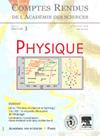谐波捕获一维准稠密体呼吸振荡的频率跳动与阻尼
IF 1.2
4区 物理与天体物理
Q3 ASTRONOMY & ASTROPHYSICS
引用次数: 4
摘要
我们使用有限温度经典场方法研究了准凝聚态中谐波捕获的一维(1D)玻色气体中的呼吸(单极)振荡及其阻尼。通过密度分布的均方根宽度在长时间内的动力学来表征振荡,我们发现均方根宽度显示出两个不同频率的跳动。这意味着1D玻色气体的振荡频率不是以前的研究中发现的单一呼吸模式,而是两种不同呼吸模式的叠加,其中一种模式的振荡频率接近$\simeq\!\sqrt{3}\omega$,另一个位于$\simq\!2\omega$,其中$\omega$是陷波频率。$\sim\的呼吸模式!\sqrt{3}\omega$在较低温度下,在准凝聚态深处主导着跳动,并可归因于由填充低能量、高占据态的粒子组成的密度分布的主体的振荡。$\simeq\的呼吸模式!另一方面,2\ω$在更高的温度下主导着跳动,接近于近乎理想的简并玻色气体状态,并归因于由高能态的热粒子组成的密度分布的尾部的振荡。这两种呼吸模式具有不同的阻尼率,主体成分的阻尼率大约是尾部成分的四倍。本文章由计算机程序翻译,如有差异,请以英文原文为准。
Frequency beating and damping of breathing oscillations of a harmonically trapped one-dimensional quasicondensate
We study the breathing (monopole) oscillations and their damping in a harmonically trapped one-dimensional (1D) Bose gas in the quasicondensate regime using a finite-temperature classical field approach. By characterising the oscillations via the dynamics of the density profile's rms width over long time, we find that the rms width displays beating of two distinct frequencies. This means that 1D Bose gas oscillates not at a single breathing mode frequency, as found in previous studies, but as a superposition of two distinct breathing modes, one oscillating at frequency close to $\simeq\!\sqrt{3}\omega$ and the other at $\simeq\!2\omega$, where $\omega$ is the trap frequency. The breathing mode at $\sim\!\sqrt{3}\omega$ dominates the beating at lower temperatures, deep in the quasicondensate regime, and can be attributed to the oscillations of the bulk of the density distribution comprised of particles populating low-energy, highly-occupied states. The breathing mode at $\simeq\!2\omega$, on the other hand, dominates the beating at higher temperatures, close to the nearly ideal, degenerate Bose gas regime, and is attributed to the oscillations of the tails of the density distribution comprised of thermal particles in higher energy states. The two breathing modes have distinct damping rates, with the damping rate of the bulk component being approximately four times larger than that of the tails component.
求助全文
通过发布文献求助,成功后即可免费获取论文全文。
去求助
来源期刊

Comptes Rendus Physique
物理-天文与天体物理
CiteScore
2.80
自引率
0.00%
发文量
13
审稿时长
17.2 weeks
期刊介绍:
The Comptes Rendus - Physique are an open acess and peer-reviewed electronic scientific journal publishing original research article. It is one of seven journals published by the Académie des sciences.
Its objective is to enable researchers to quickly share their work with the international scientific community.
The Comptes Rendus - Physique also publish journal articles, thematic issues and articles on the history of the Académie des sciences and its current scientific activity.
From 2020 onwards, the journal''s policy is based on a diamond open access model: no fees are charged to authors to publish or to readers to access articles. Thus, articles are accessible immediately, free of charge and permanently after publication.
The Comptes Rendus - Physique (8 issues per year) cover all fields of physics and astrophysics and propose dossiers. Thanks to this formula, readers of physics and astrophysics will find, in each issue, the presentation of a subject in particularly rapid development. The authors are chosen from among the most active researchers in the field and each file is coordinated by a guest editor, ensuring that the most recent and significant results are taken into account. In order to preserve the historical purpose of the Comptes Rendus, these issues also leave room for the usual notes and clarifications. The articles are written mainly in English.
 求助内容:
求助内容: 应助结果提醒方式:
应助结果提醒方式:


